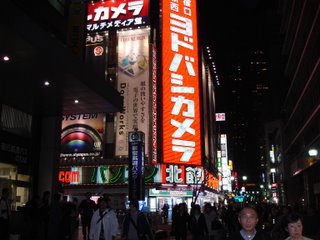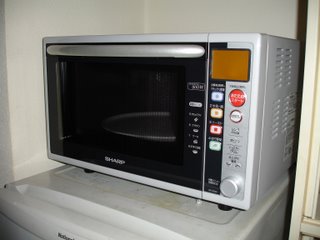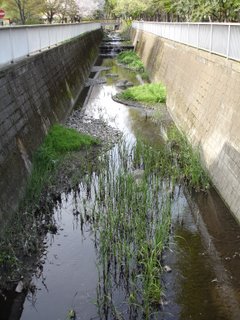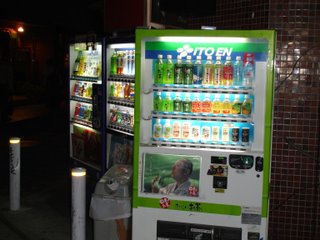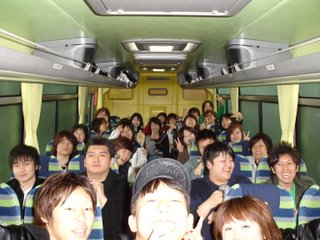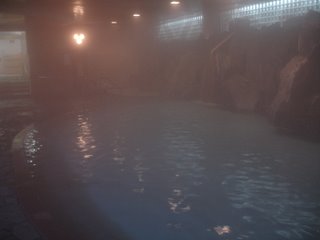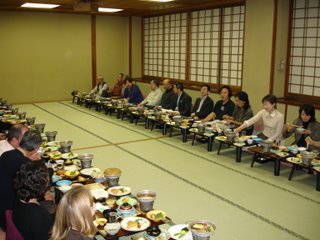Playing Doctor
For me, the week started on Monday. Not there was anything boring about Sunday (as you will see), but events from last Friday led me to Monday, and so on. Last week I was confounded by a cold that seemed to get better then worse everyday. On Friday I was out with some of the crew when I got a terrible sinus headache like someone was pressing their thumb into my cheek just below my right eye as hard as they could all day long. Suffice to say I was in a sour mood. We ate dinner at Tucci Bennuch, where I tried to focus on eating so hard that I ignored the entire conversation going on across the table. Something about whether or not the food in the salad bar was vegetarian or not, which seemed like it was a lot more trouble finging out than it was worth. At home I took a handful of pills (11, to be exact), failed to sleep for several hours, and made plans to see the doctor on Monday. I actually tapped into my supply of leftover meds from when I had my wisdom teeth removed thinking that either the pain would go away or I would be so high it would no longer matter.
I really can’t complain about going to the doctor other than to say that I had to wait a lot longer than I felt was necessary and it was all my fault. Based on my conditions, my medical background (my father works in a hospital), and the fact that I have had this affliction before, I already knew and wrote on the visitation form that I had a sinus infection hoping this would speed everything along a bit. Considering it was a walk-in clinic, I assumed that I could come in, get some pills, and go home. However, since this was Golden Week everyone who had so much as the sniffles thought today would be a good day for a visit, and there was only one doctor seeing the people filling every chair and couch in the waiting room. The time stretched on until I realized I had been waiting for almost three hours. Had I gotten there at 9 when the clinic opened I might have waited about 15 minutes.
When the door opened and my name was called, I practically ran inside. The doctor was a bit of an eccentric, evident in his statically charged hair and clothing. He asked me, in Japanese, if I preferred to speak English, Japanese, or French. English, please, I said. He poked me in the face, looked at my throat and said I had sinusitis. I need to stay warm, not eat spicy food, and take antibiotics for the next week, he told me. The total time spent in the doctor’s office, and I mean his actual place of healing, three minutes. After that I met up with a few others in the park and played Frisbee for a while. My cheek didn’t stop hurting for another couple of days.
Harajuku
 On Sunday Joanne took me to Harajuku. I had been there before for the Hanabi (cherry blossom festival) work party, but that was entirely in the park and she wanted to show me around the whole area and have dinner at the one good Mexican restaurant that anyone knew about. But the most memorable thing is the first thing you see coming out of the station, and that the is bridge crowded with one third Japanese who decided not to go out of town for the week, on third tourists, and the rest people in their make-up and costume that put American goth and punk kids to shame. You can see all kinds, girls in skirts with zombie faces, Victorian era black ballroom outfits, and the guy who looks like he was standing next to the north tower when it collapsed. I have no idea if that last guy is trying to make some political statement or reference to 9-11, but he is white and present every time I have gone there.
On Sunday Joanne took me to Harajuku. I had been there before for the Hanabi (cherry blossom festival) work party, but that was entirely in the park and she wanted to show me around the whole area and have dinner at the one good Mexican restaurant that anyone knew about. But the most memorable thing is the first thing you see coming out of the station, and that the is bridge crowded with one third Japanese who decided not to go out of town for the week, on third tourists, and the rest people in their make-up and costume that put American goth and punk kids to shame. You can see all kinds, girls in skirts with zombie faces, Victorian era black ballroom outfits, and the guy who looks like he was standing next to the north tower when it collapsed. I have no idea if that last guy is trying to make some political statement or reference to 9-11, but he is white and present every time I have gone there.
With all of the tourists about I start to feel less and less impressed with the whole idea of “being in Japan.” When I first got the job everyone and their cousins had already done sometime like that last year. So it was partially less thrilling than it could have been, but now that I can go to the store, ride the train, eat in a restaurant and see at least one other white person, usually speaking English, I feel less unique, and realize that this is just another big city in the world. This may also because I am from the big city and having people generally ignore me and crowd me across streets when the light turns green makes me feel as though I have never left. But what really makes dealing with the honkies a hassle is the fact that they don’t even acknowledge you. Here I am giving them a nod as if to say, “Hello, I’m a stranger here, too,” and they are quick to look away lest I ask them for money.
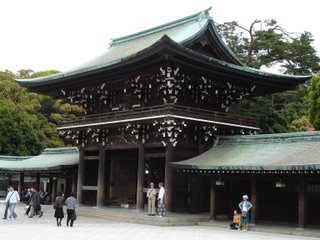 The closer we got to the temple the more foreigners we saw, but the more obvious the reason, too. Everything about the temple was packaged and clean for visitors. Even the monks that walked in full dress behind the roped boarders looked far too clean and proper than real monks should. There were gift shops all over the place selling the same small stitched envelopes with coins inside for luck and incense to burn in memory of lost loved ones. The walls had a fresh coat of paint so everything seemed newer than when it was actually built. But please ignore my criticisms and believe me when I say that it was impressive to see the ornate carvings that went around the entire wall, larger than a couple of football fields and sporting gates that you could get an army through in a matter of minutes. The whole place is encompassed in a forest so thick that it muffles out the sounds and blocks the lights of the nearby city. You actually forget that you are in Tokyo, but maybe I’m just used to traveling outside of town to see a monument this big.
The closer we got to the temple the more foreigners we saw, but the more obvious the reason, too. Everything about the temple was packaged and clean for visitors. Even the monks that walked in full dress behind the roped boarders looked far too clean and proper than real monks should. There were gift shops all over the place selling the same small stitched envelopes with coins inside for luck and incense to burn in memory of lost loved ones. The walls had a fresh coat of paint so everything seemed newer than when it was actually built. But please ignore my criticisms and believe me when I say that it was impressive to see the ornate carvings that went around the entire wall, larger than a couple of football fields and sporting gates that you could get an army through in a matter of minutes. The whole place is encompassed in a forest so thick that it muffles out the sounds and blocks the lights of the nearby city. You actually forget that you are in Tokyo, but maybe I’m just used to traveling outside of town to see a monument this big.






This time in the park I got to see the Rockabilly Club, though people around here call them the dancing Elvises. I might have something to do with the fact that no one here is from an area where a rockabilly may be found, nor would they have come across one through work or school, but they are out there. You can find them with slick hair and an all-leather outfit sporting a perpetual “fuck you” expression on their face. They listen to various kinds of butt rock, a style which I am at a loss to describe as anything other than bad. But they can basically be exemplified by the guy who wasted no time walking over to the bushes along the walking path and peeing into them as soon as we entered. I asked Joanne what she thought about it and she said it happens so often that she no longer cares. So I have more of this to look forward to.
We played cards for a couple hours and watched families toss around Frisbees and kick soccer balls. At key intersections of the trails venders had set up shop and sold drinks and snacks like baked balls of dough wrapped around calamari, skillet fried noodles, and grilled salted bites of chicken on a stick. We got some chicken and watched the Elvises. I should mention here that it is extremely rude to eat and walk around at the same time. Even with the rush attitude that most people have, you should stop to eat. Similarly, it is illegal to walk and smoke at the same time, but this is because such crowded streets result in people getting burned all the time by careless smokers. Getting back to the food, it is, contrary to American venders, really good.
All of these snacks made us hungry for dinner, but on the way to the restaurant I constantly thought about an episode of Iron Chef where the challenger was a Mexican food enthusiast. The show talked about him and how he went to Mexico and started a restaurant here in Tokyo to teach people what real Mexican food is, but I have no idea where to find it. Getting to this restaurant was a bit of a journey, we walked through several blocks of people so tightly packed that it was inadvisable to stop at any of the numerous shops lining the road since there would be no room for you carry additional mass. While most of the shops where clothing, some of them specialized in the kinds of outfits you would wear if you wanted to hang out on a bridge and have your picture taken. I suggested Joanne get some pre-torn fishnet stockings, but she had nothing they would go with.
When we got to the restaurant we were seated right away. The hostess told us that they were completely booked up for a party that was supposed to start in an hour and a half, but for now the place was completely empty. The whole restaurant was underground, and if you were expecting to drive past it and see it, you would easily miss the tiny structure erected over the stairway leading under the street. And if you think the underground location makes the place small, well, it was larger than most restaurants I have been to in the states with two levels and a fireplace in the main dining area. I ordered enchiladas and Joanne got chicken mole as well as an order of chips and guacamole. We drank sangria and got our food in under ten minutes. I swear I have never had to wait for food in Japan like I have in the states. The food was good, about what you would expect for an attempt at making cuisine from across the ocean without importing authentic chefs, and really expensive. My dish alone was 2000¥, and the whole meal was around 7500¥. Yikes. It’s a good place to go if you're seriously Jonesing for Mexican, but not more often than that.
This was the most western day I have had since I got here.
Tachikawa
Karen suggested we break free of sitting around hoping for the weather to improve and head to Tachikawa, the huge shopping district. Try to imagine what the Mall of America would be like if it encompassed an entire district. Buildings here are large, commercial, and crowded such that there are several different ways of walking between them. You can either be on the street or up in the air on walkways that curve and bend back on themselves like cities pictured on the covers of sci-fi novels from the fifties except without the aliens that have the bodies of well-endowed supermodels and the heads of squids. While I would like to say that I hated this part of the city, what with there being a picture on my computer of me scowling in front of the Mall of America and the neighboring Ikea, I found this to be the coolest place I have yet visited.
Not to discount the various temples and historic grounds that I have been to, but there was something dreamlike about the way the entire area was designed to fit not just a bunch of stores, like everywhere else, but a bunch of America-sized stores with multiple levels of shopping heaven. As you know the Japanese are not real big of wide aisles and open lobbies, so every store is so crammed with merchandise that you could spend an afternoon in one store and miss a good portion of what they’re offering. Karen and I walked into one shopping center and found a food court that stretched an entire block filled with pastries, sandwiches, and coffee shops. I swear, wherever you are in this city you are never far from a keitai shop, salon, or Starbucks.
Depending on where you go in Tokyo, the style of building is going to change dramatically. Shinjuku, for example, enjoys less severe shaking than most of the city during an earthquake and can therefore afford to build skyscrapers that can be seen from miles away. In parts more prone to damage, buildings are smaller and are built to sway their narrow bodies in order to survive the shakes. If I had to guess, Tachikawa would also enjoy such a benefit as Shinjuku since a severe quake would send most of the buildings, walkways, and raised train tracks down into the ground. Giant boxes have little swaying power and tend to crumble faster under pressure. As the Nambu Line raced away overhead, well over six stories in the air, I wondered what would happen if a quake hit right then.
When the rain got worse we took cover in the outdoor lobby of a movie theater. Since we really had no concrete plan, we played with the idea of seeing a movie, only to find that it was near impossible to figure out which movies were in English with subtitles and which were dubbed. We finally asked some woman what she knew and after a few minutes of charades, decided that, while we were interested in seeing a movie, we weren’t 1800¥ interested. On average, though, it takes about six months for a popular movie to make the trip through the translation machine and come out on this side of the ocean. The cost is near what it would cost in the states to just buy the DVD, but, new DVDs cost anywhere from $30-$40, so there’s no point in just buying it to see if it’s any good. At the theater, I had my heart set on seeing V for Vendetta since it had come out the day I left for Japan, but though that renting it for around 400¥ was good enough.
We walked around one of the raised walkways toward a large building advertising a clothing store (I think) and a bookstore. The rain was little more than a drizzle, but enough to soak us through had it not been for the plastic awnings decorated with small LEDs that cycled through all six colors of the visible light spectrum to create an LSD feel of a floating rainbow path that looked down on a street where traffic never seemed to move. On my left I noticed a single walkway branch off to a large building with a Dunkin Donuts embedded in the corner right where the path met. I was starting to think this place looked less like some futuristic utopia and more like Heaven.
The bookstore had a pretty good English section with a number of dictionaries, magazines and books. Most of the books you can get here are pretty good, actually, but a lot of them are bestsellers. Thankfully, people in America make a bestseller of a few genuinely good books, so I have some options when I shop, even if they cost twice as much for the paperbacks (about the same for hardcovers). Magazines are the same way, mostly made up of popular news publications, fashion, and porn (there were the same numbers of each). Karen and I looked for a while and split buying a couple of travel guides for Tokyo so that between her, Russell, Joanne, and I we had a total of four to look at or borrow.
We spent the rest of the afternoon into early evening reading our new books and studying some Japanese. I have to admit that seeing Karen go through her new dictionary made me feel rather bad that I had devoted so little time to trying to learn Japanese. While we were sitting in Starbucks at the far end of the giant food court, I looked at some of her notes and tried to learn a little with her. After a few minutes I got up to ask for water. I had to ask Karen what the word for water was before going to the counter. Asking for something is easy, just the thing and "please," but I got completely lost when the clerk asked me if I wanted ice in my cup. I knew that’s what she asked me when she switched to a near perfect English to ask me again. If I actually drank more coffee, I could get by at just about any Starbucks as people who work there tend to speak the language.
Ueno
 I laid low for a few days and healed. By Wednesday I was feeling the need to get out again and go where I had never gone before. I ran into Karen and we decided that Ueno was a cool place to check out based on our brand new travel guides. So, to be honest, I had no idea where we were going, but Karen said to bring my book and that it would take about 45 minutes to get to this place that had a big park and some other stuff. Considering I had done little, ok, no planning on what I should see during this week.
I laid low for a few days and healed. By Wednesday I was feeling the need to get out again and go where I had never gone before. I ran into Karen and we decided that Ueno was a cool place to check out based on our brand new travel guides. So, to be honest, I had no idea where we were going, but Karen said to bring my book and that it would take about 45 minutes to get to this place that had a big park and some other stuff. Considering I had done little, ok, no planning on what I should see during this week.
 The Ueno park was right off the train, just like the on in Harajuku. I could see the crown of people moving along the wide paths in the thick trees. I began to wonder just how many people actually went out of town during this week since so many managed to find their way here to make my visit just a little bit slower. The first place we went to was the local science museum, one of many in the area. Standing not far from a built to scale blue whale mounted alongside the building, we talked about the possibility of going inside and having a look around. This day was beautiful, and there was no reason to pay to go inside for a few hours and look at sculpture when there was so much outside to look at. Through a fence by the street was a giant gate that had been moved here as part of the exhibit. Despite only being a small part of the entire castle, it was a formidable piece, and gave me a good idea how big the whole thing must have been. Another time, perhaps.
The Ueno park was right off the train, just like the on in Harajuku. I could see the crown of people moving along the wide paths in the thick trees. I began to wonder just how many people actually went out of town during this week since so many managed to find their way here to make my visit just a little bit slower. The first place we went to was the local science museum, one of many in the area. Standing not far from a built to scale blue whale mounted alongside the building, we talked about the possibility of going inside and having a look around. This day was beautiful, and there was no reason to pay to go inside for a few hours and look at sculpture when there was so much outside to look at. Through a fence by the street was a giant gate that had been moved here as part of the exhibit. Despite only being a small part of the entire castle, it was a formidable piece, and gave me a good idea how big the whole thing must have been. Another time, perhaps.
Down the path was a carnival set up for the local children, including food stands, local performers that were made up of anyone with a talent and a hat to catch money in, and rides that could be quickly assembled and removed when the season changed. When we got out of the crowd there were a lot of classic buildings, temples, sculptures, and grave sites with signs that explained their historical significance English and Japanese. How thoughtful. Karen and I paid a few dollars to walk through a classic temple that has seen little refurbishing, so its age and original beauty showed despite its cracked paint and rusted fixtures. Inside were two very large carved wooden dragon masks that you could sled a few people down a hill in, and a dark metal gong like disk with an original map of Japan and its prefectures on it. No pictures were not allowed inside, sorry, folks.
 Outside was a memorial to the bombing of Hiroshima. When the son of the owners came to find the house gone, there was a small bit of wood still burning in the rubble. He took the flame, built a larger fire, and kept it going as a sign of his anger at the United States. Eventually he realized the problem with carrying a vendetta around and the fire came to symbolize the desire for peace rather than a need to revenge. They keep the fire going to this day as a reminder of the destruction war can do. I have heard a lot of amazing things about the actual cities where the bombs were dropped and the dedications that have been made there. It’s something that people still carry around with them in a lot of ways, still evident in some of their art, movies, and even comic books both in good and bad ways. Other teachers tell of people who come and yell at them for being white and, therefore, American. I haven’t seen this yet, but everyone assures me I will.
Outside was a memorial to the bombing of Hiroshima. When the son of the owners came to find the house gone, there was a small bit of wood still burning in the rubble. He took the flame, built a larger fire, and kept it going as a sign of his anger at the United States. Eventually he realized the problem with carrying a vendetta around and the fire came to symbolize the desire for peace rather than a need to revenge. They keep the fire going to this day as a reminder of the destruction war can do. I have heard a lot of amazing things about the actual cities where the bombs were dropped and the dedications that have been made there. It’s something that people still carry around with them in a lot of ways, still evident in some of their art, movies, and even comic books both in good and bad ways. Other teachers tell of people who come and yell at them for being white and, therefore, American. I haven’t seen this yet, but everyone assures me I will.
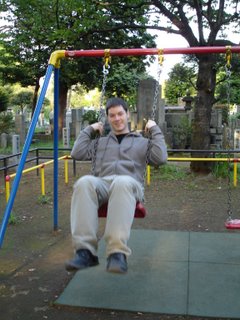 Being completely at the will of Karen led me to a large cemetery. Later I found out it was the largest in the country, and you have to understand that, due to low land area and a high population, the graves are packed in so close the coffins practically rub against one another. In the center there was a playground for children to occupy themselves with while the adults spent some time in mourning. What a clever idea, I thought. This is something they should really have in America, but I suppose people will dismiss it as being too morbid, attracting children who live closer to the cemetery playground than the park one. I have to say in my defense that it was Karen’s idea to take picture of me on the swing, though I will admit that I was thinking it. We also joked that next year, during Hanami, we should have the work picnic here in the park.
Being completely at the will of Karen led me to a large cemetery. Later I found out it was the largest in the country, and you have to understand that, due to low land area and a high population, the graves are packed in so close the coffins practically rub against one another. In the center there was a playground for children to occupy themselves with while the adults spent some time in mourning. What a clever idea, I thought. This is something they should really have in America, but I suppose people will dismiss it as being too morbid, attracting children who live closer to the cemetery playground than the park one. I have to say in my defense that it was Karen’s idea to take picture of me on the swing, though I will admit that I was thinking it. We also joked that next year, during Hanami, we should have the work picnic here in the park.
Somewhere in all of our wandering we got lost a few times. For those of you who intend on visiting I will tell you that you can get around just fine without a map as long as you take note of the surroundings and notice when the stores end and the apartments begin. It will be a pretty sudden change from bright red and yellow signs, LEDs, men with megaphones, and people handing out packets of tissues with the company logo on them to empty streets and drab, gray buildings with blank steel doors with the narrow shatterproof window. But if you do play it safe you are likely to miss the temples and old structures that were literally just left standing and developed around. In Shinjuku, for example, you will be walking down a block of giant commercial buildings and suddenly there is a break in the wall of concrete and glass with a row of trees and an old stone path leading to a temple.
 When we were searching through the labyrinthine streets of Ueno that would turn the city planners of St. Paul green, I noticed the cables that ran through the city about one story above the street. They connect every building, every pole, and double back on themselves for fail safes and backups. The cables here are prevalent to the point of being pervasive. Once you notice them they seem like a net ready to fall down and catch a dinosaur. They’re thick and black; little is made to hide them from contrasting with every surface and the sky. And this is exactly how the Japanese live and function, I thought. Once the newest thing comes out they are quick to implement it and make sure that everyone has it. You can hardly buy a CRT TV anywhere as every store carries the HD thin models, phones become cheap and disappear within months of coming on the market, and even cars are cheaper to buy new than to hang on to the old one. When the cabled came out there was no place else to put them, and everyone had to have one. It’s a shame in a way, but something you can become accustomed to very quickly.
When we were searching through the labyrinthine streets of Ueno that would turn the city planners of St. Paul green, I noticed the cables that ran through the city about one story above the street. They connect every building, every pole, and double back on themselves for fail safes and backups. The cables here are prevalent to the point of being pervasive. Once you notice them they seem like a net ready to fall down and catch a dinosaur. They’re thick and black; little is made to hide them from contrasting with every surface and the sky. And this is exactly how the Japanese live and function, I thought. Once the newest thing comes out they are quick to implement it and make sure that everyone has it. You can hardly buy a CRT TV anywhere as every store carries the HD thin models, phones become cheap and disappear within months of coming on the market, and even cars are cheaper to buy new than to hang on to the old one. When the cabled came out there was no place else to put them, and everyone had to have one. It’s a shame in a way, but something you can become accustomed to very quickly.

The pinnacle of the trip was a small park and temple ground we stumbled into completely by chance. The area was surrounded by a steep slope decorated with lilacs bushes and a winding path through them lined with people. Inside the great archway to the grounds were statues decorated in traditional clothing of some kind. I’m afraid I never saw the plaque for this one, but they appeared to be higher class garments with ornate stitching and color patterns of flowers and exotic birds. Off to the side was an open area where a local group was setting up drums for a show. We must have gotten there early since few people had gathered and we got really good spots to watch. Within fifteen minutes there wasn’t anywhere to stand.
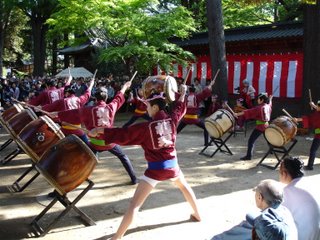 The show was made up of classic drum lines performed by kids aged from four to 18, I assume. At one point the leader jumped in and played a few round with them, out of costume, but with incredible skill. I don’t know much about this form of music, but over the course of the show they demonstrated songs with different drum arrangements, by hitting the body and the skin on the drum to make different sounds, and by the leader, who appeared to be the oldest, shouting commands to the others to keep them in sync or signal a changeover. The best part was when they arranges three drums in a line and had six people running around the peripheral two beating on two drums at a time and turning in circles. I’m surprised they did so well. The exhaustion was evident between songs. With enough people there were a few that could sit out for a while and rest, breathe heavily and sweat into their elaborate costume, tapping a partner out when they needed a break. I surely would have passed out in a few minutes. When the show was over, I was about ready to.
The show was made up of classic drum lines performed by kids aged from four to 18, I assume. At one point the leader jumped in and played a few round with them, out of costume, but with incredible skill. I don’t know much about this form of music, but over the course of the show they demonstrated songs with different drum arrangements, by hitting the body and the skin on the drum to make different sounds, and by the leader, who appeared to be the oldest, shouting commands to the others to keep them in sync or signal a changeover. The best part was when they arranges three drums in a line and had six people running around the peripheral two beating on two drums at a time and turning in circles. I’m surprised they did so well. The exhaustion was evident between songs. With enough people there were a few that could sit out for a while and rest, breathe heavily and sweat into their elaborate costume, tapping a partner out when they needed a break. I surely would have passed out in a few minutes. When the show was over, I was about ready to.
Yokohama Yokohama was the first coordinated effort by all of the crew (Russell, Karen, Juniper and I) to go out and see a place. Russell had been here before, but was willing to guide us through the cool sections and give us tips on what to see. The best part about Yokohama, he said, is Chinatown. I have been to Chinatown in the SanFran, so this was going to be a treat. This is also the farthest that I have ever traveled from home, taking a one hour train ride and switching a few times to get there. people used to joke with me and say that anywhere in Japan in ten minutes away from anywhere else by train. I am starting to realize that this is not the case, and even a short trip could take a while from frequent stops and only going at top speed for a few minutes at a time. There are a few trains that are “Rapid,” trains that skip over the less popular stops on the way across town, but you have to get a popular place to catch one.
I should also mention that this is the first time that I have seen the ocean here as well. But because of this prime piece of real estate the area is a haven for tourists and locals who want a relaxing day on the border of town. I have seen pictures of Japan with white sandy beaches and grass huts to sip margaritas under like Mexico, but this area had a port design to it more like, well, San Francisco. There is a large amusement park with the second largest Ferris wheel in the world behind the largest in Osaka. Just looking at it made me feel a little dizzy. We walked up to the entrance, each level of the stairway was marked off with a sign that told how long you had left to wait. There couldn’t have been more than thirty minutes worth of people in line, but we decided that we would come back on the way out.
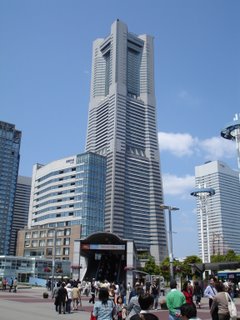 Across the road from the park is a string of hotels lining the coast. Each appear as mountains of glass that branch out to maximize the surface area, every room with its own window and view that stretches for miles. This is especially true of the Landmark Tower, the largest in Japan (and the 33rd largest in the world). For a measly 1000 yen you can travel to the top and hang out in the sky garden and look across to the other side of the country. Curiously, we decided that it would be better to come back to this on the way out. I was really excited to look out and take some pictures for the old blog here, but conceded that going to the first attraction right out of the station was the thing that everyone did, and hitting it on the way out was better.
Across the road from the park is a string of hotels lining the coast. Each appear as mountains of glass that branch out to maximize the surface area, every room with its own window and view that stretches for miles. This is especially true of the Landmark Tower, the largest in Japan (and the 33rd largest in the world). For a measly 1000 yen you can travel to the top and hang out in the sky garden and look across to the other side of the country. Curiously, we decided that it would be better to come back to this on the way out. I was really excited to look out and take some pictures for the old blog here, but conceded that going to the first attraction right out of the station was the thing that everyone did, and hitting it on the way out was better.
One of the big attractions here is the silk museum. A small museum dedicated to the production, use, and history of silk featuring some beautiful tapestries and kimonos dating back several centuries. My favorite section was a series of photographs detailing fashion trends in this country over the decades, including the period immediately following World War II when American fashion became very popular. Near the end the production stage was explained describing the lifecycle of the worm, which brought back a lot of what I learned in my into level entomology class. Probably the most interesting section was where they showed common clothing items next to plastic cases containing the number of cocoons it takes to make each one, a kimono takes over four thousand, for example.
 Further down the road we came to Chinatown, the busiest place I have ever seen. The streets were so packed that it was near impossible to walk without running into somebody every step of the way. Each block had a recreation of a temple with ornate decoration and coloring, but was so new that it seemed almost fake amid the bustling city and rain-gray buildings. In a shop Russell bought a stamp with the Chinese character for his name on it that the man carved right there in front of us. He wanted a thousand for it but Russ talked him down to 500.
Further down the road we came to Chinatown, the busiest place I have ever seen. The streets were so packed that it was near impossible to walk without running into somebody every step of the way. Each block had a recreation of a temple with ornate decoration and coloring, but was so new that it seemed almost fake amid the bustling city and rain-gray buildings. In a shop Russell bought a stamp with the Chinese character for his name on it that the man carved right there in front of us. He wanted a thousand for it but Russ talked him down to 500.
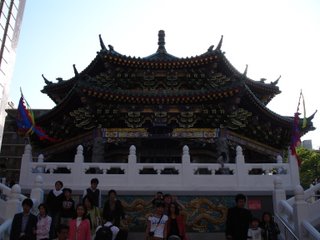 Russ actually came to Japan after teaching for a while in China. He knows a bit of the language and has several tidbits of information on what the real China is like, such as buying a bun with a piece of pork in the center costs about 300 here, but a quarter could buy you a dozen on the streets of Hong Kong. It was damn tasty, though. In a Chinese restaurant He had a really good time talking to the waiter about our various food problems, no meat or wheat for Juniper, no fish for him or I (he’s allergic, I just don’t like it), and no beef or pork for Karen. When the guy left Russ know that he was pissed at us, but brought us the food in good time anyway. Despite the fact that I wasn’t all that hungry, I must have eaten more than my share when the two girls confessed to being stuffed. Thinking about going to China now? Russ asked me. Yes, I said. Man, Chinese food is delicious.
Russ actually came to Japan after teaching for a while in China. He knows a bit of the language and has several tidbits of information on what the real China is like, such as buying a bun with a piece of pork in the center costs about 300 here, but a quarter could buy you a dozen on the streets of Hong Kong. It was damn tasty, though. In a Chinese restaurant He had a really good time talking to the waiter about our various food problems, no meat or wheat for Juniper, no fish for him or I (he’s allergic, I just don’t like it), and no beef or pork for Karen. When the guy left Russ know that he was pissed at us, but brought us the food in good time anyway. Despite the fact that I wasn’t all that hungry, I must have eaten more than my share when the two girls confessed to being stuffed. Thinking about going to China now? Russ asked me. Yes, I said. Man, Chinese food is delicious.
With all of us tired from walking and full from dinner, we got back on the train a stop down from where we arrived and headed toward home. About three minutes before the exit to the Ferris wheel and tower, Russ asked if I was the only one who still wanted to go up. I could go either way, really, I said. Then everyone chimed in with the same. There is nothing worse than a group of people and no decision maker among them. Ultimately, none of us were married to going up either. Sad, maybe we should have gone up front.
Costco
When I think of Costco I think of America. Don’t get the wrong idea here, I’m not talking about flag waving and all that other crap that people mean when they throw the word “America” around like it was candy at a parade, I mean loud, commercial, big, heavy, and convenient. Well, maybe not entirely convenient. Like every other trip I took this week there was an hour on the train and a bit of walking thrown in for good measure. Russ took Juniper and I along on this crazy shopping venture that occurred in an obscure little area on the outskirts of Tokyo, but had all the earmarks of a good, American suburban shopping sprawl.
For starters there was nothing out there. I mean a lot of open fields and dirt just scattered about with no apparent plan to turn into something foreboding and cheap any time in the near future. There were a few apartment buildings around with plenty of breathing room, as well as a convenience store and a few small shops along the road. We followed the road past the shops, past a store that was several acres and two floors of superstore painted green, and across from the pet store that could supply every animal in the country, wild and domesticated, to a building that was the old, familiar warehouse box, Costco. Cars lined the block to get into the multilevel garage at the side while men reflective vests ushered them through. The people at the door checked Russell’s ID and welcomed us in English. By now I was already starting to forget that this was Japan.
The inside is America Costco; I need not describe more to you than that. There are all of the same sections, meat, bakery, computers, appliances, lawn furniture, etc. Except for a few additions in the fish area and some gaps like the lunchmeat area, Japanese people apparently don’t eat lunchmeat, it was the same. We hit every aisle and area in no particular order, filled two carts with food and other items, and hauled it up to the front. I have been saying ever since I found out that this place was here that I was ready to drop a couple hundred dollars there, but when I say things like that I’m kidding. When I saw the register ring up the total (64,000 yen, or about $600), I nearly hit the floor. This was divided up among four of us, Karen included, to be sorted out later. Shipping would take about a week and cost another 2000 yen, but it was worth it. We grabbed a few items from the cart, I got a bag of cheese to make pizza that I didn’t trust to the delivery guy, and we had dinner in the cafeteria.
I remember eating a slice of pizza when Russell pointed out that there was grease running down my arm, and sure enough there was a clear orange line running from my thumb to my elbow, branching off a couple of times to get around a few small hairs. Along the edge of the table line a man with a bullhorn proclaimed that a member could get 1000 yen if they signed up now with a new member. I felt greasy and tired, there were children running around screaming and overweight people scarfing down two or three pieces at a time. In the check-out area people pushed into one another without ever saying “excuse me.” Something about this place had changed them. Being a part of it already, I had no idea what it could be.






















